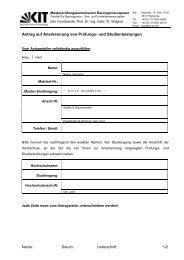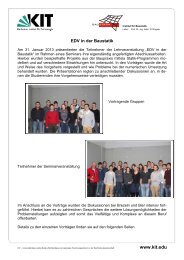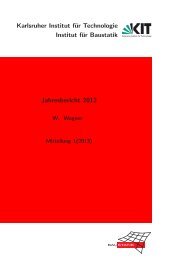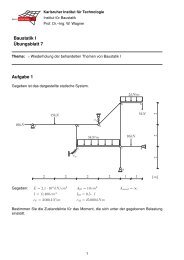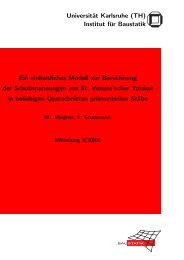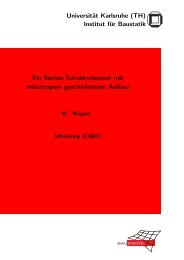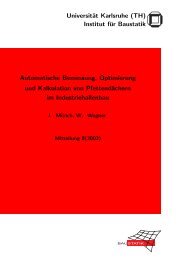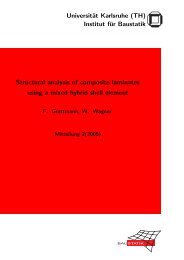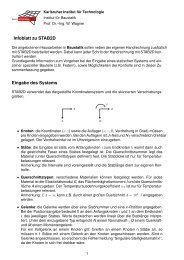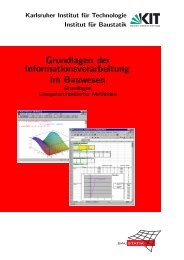Universität Karlsruhe (TH) - am Institut für Baustatik
Universität Karlsruhe (TH) - am Institut für Baustatik
Universität Karlsruhe (TH) - am Institut für Baustatik
Create successful ePaper yourself
Turn your PDF publications into a flip-book with our unique Google optimized e-Paper software.
the strain field and the non-constant part.<br />
Mixed variational principles provide the basis for the discussed finite element techniques.<br />
Assuming linear elasticity a Hellinger–Reissner functional has been used in e.g. [9]. For<br />
general nonlinear material behaviour a three field variational functional with independent<br />
displacements, stresses and strains is more appropriate. Within the so–called enhanced strain<br />
formulations the independent stresses are eliminated from the set of equations using orthogonality<br />
conditions and a two field formulation remains, [15]. For shells this method has been<br />
applied enhancing the Green–Lagrangean membrane strains e.g. in [16, 17]. The corresponding<br />
developments for so–called solid shell elements have been presented in e.g. [18, 19]<br />
A further new development on enhanced strain formulations is based on a modified Hu–<br />
Washizu formulation, [20]. The functional for plane elasticity problems contains displacements,<br />
stresses, strains and enhanced strains as independent variables. An effective method<br />
to avoid transverse shear locking is based on assumed shear strain fields first proposed in<br />
[21], and subsequently extended in [22, 23, 24]. The variational basis for these methods is the<br />
Hu–Washizu functional.<br />
An important issue within the context of developing a finite shell model is the number and<br />
type of rotational par<strong>am</strong>eters on the element. Mostly general shell theories exclude explicit<br />
dependence of a rotational field about the normal to the shell surface which leads to a five<br />
par<strong>am</strong>eter model (three displacements and two local rotations). Use of 5 degree–of–freedom<br />
fr<strong>am</strong>e requires construction of special coordinate systems for the rotational par<strong>am</strong>eters. Considering<br />
the so–called drilling degree-of–freedom leads to a finite element discretization with<br />
six nodal par<strong>am</strong>eters. This has some advantages since both displacement and rotation par<strong>am</strong>eters<br />
are associated with a global coordinate fr<strong>am</strong>e. On the other hand a larger set of<br />
algebraic equations has to be solved, e.g. [25].<br />
The new aspects and essential features of the present formulation are summarized as follows:<br />
(i) The kinematics of the shell for finite deformations including transverse shear strains<br />
is formulated assuming an inextensible director field. The nonlinear variational formulation<br />
is based on a Hu–Washizu functional using a material representation with<br />
independent displacements, stresses and strains. The consideration of arbitrary nonlinear<br />
constitutive models is possible. As an ex<strong>am</strong>ple we implement isotropic plasticity<br />
with hardening for small strains. Due to the inextensibility of the current director vector<br />
the plane stress condition has to be enforced.<br />
(ii) Convergence and stability conditions on the construction of interpolation functions for<br />
the independent stress resultants and strains are investigated. As result the derived<br />
mixed hybrid quadrilateral element fulfills the membrane patch test and bending patch<br />
test and possesses the correct rank. Partly the element matrices are integrated analytically<br />
which leads to a fast and effective stiffness computation.<br />
(iii) We test the element formulation within several nonlinear ex<strong>am</strong>ples including inelastic<br />
material behaviour and stability problems. The results are compared with those<br />
obtained with four–noded enhanced strain elements (EAS-shell [17]). Especially for<br />
large load steps the new element needs essentially less iterations compared with the<br />
EAS–elements.<br />
3




